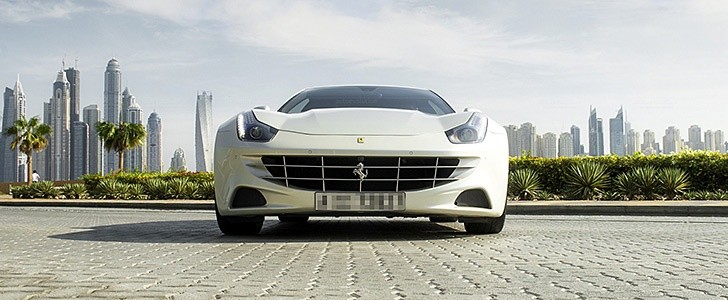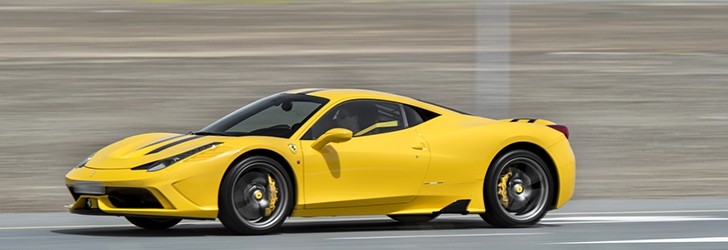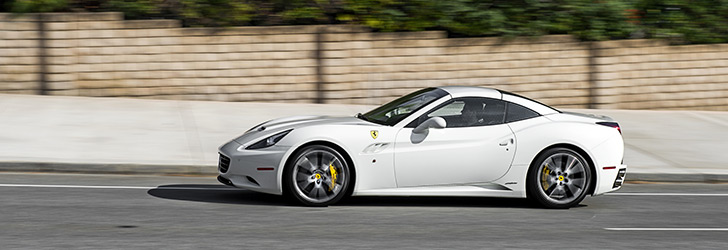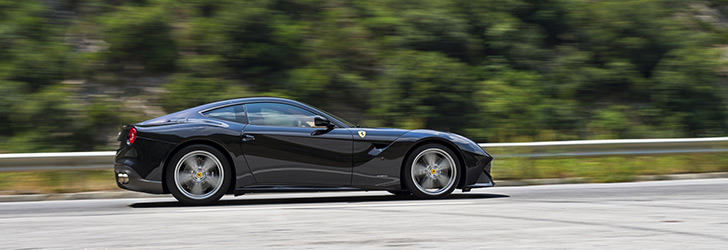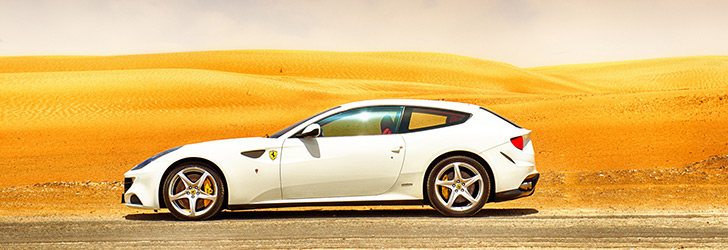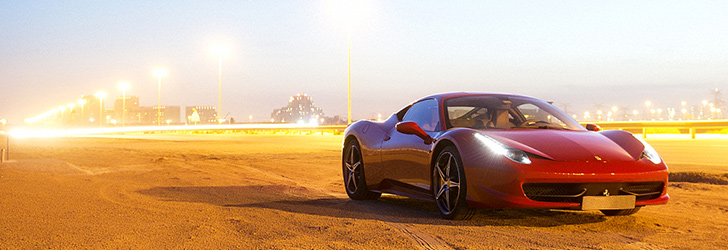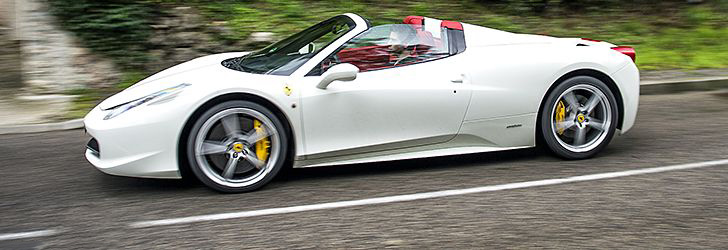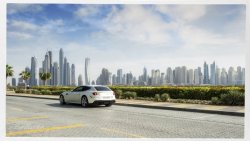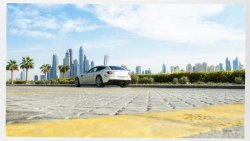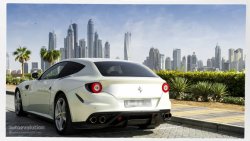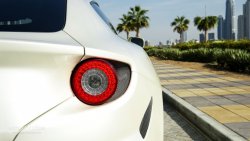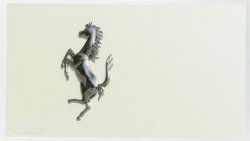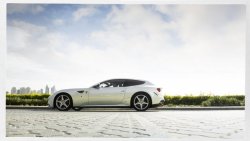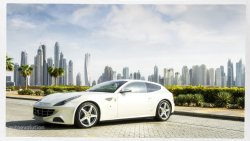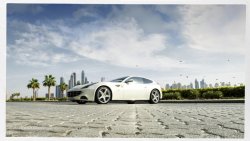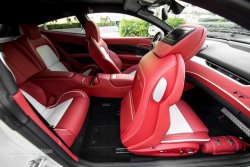FERRARI FF Review
OUR TEST CAR: FERRARI FF 2013
Whereas other models in Ferrari’s range can simply thrill their drivers and provide some accommodation on top of that, the FF has a much more complex role - it needs to find a fine balance between emotions and comfort.
You realize that you’ve met a different breed of Ferrari even before you actually get to know it, as the generous door provides easy access. Getting into the back is a bit more complicated, as you have to somehow drop yourself into the seat.
Speaking about the seats, these are ample enough and provide proper padding in order to support long trips. However, after a few hours in the car we did feel the need for more comfort in the rib cage area. It’s interesting how the 458’s seats faired better when it came to this.
Rear passengers are treated with seats that provide enough comfort and so does the space in the back, but you’ll have to keep the duration of the trip under a certain limit. Of course, you can also order a rear seat entertainment system. Compared to the rear-seat experience offered by the Bentley Continental GT, the FF is in a totally different league, showing the Brit a superior smile and all this due to the space difference.
As for the soundproofing, this is an example that proves the FF possesses the balance we were talking about in the chapter’s introduction. Everybody in the car can be fully aware of the V12’s mightiness, but the rest of the sounds are kept outside the cabin.
When it comes to ergonomics, the Ferrari FF is divided between providing a pleasant overall experience and including two or three elements that cost it serious points. Judging by the aforementioned steering wheel arrangement, Ferrari seems to be convinced that there’s no problem in making car interiors that feature a totally unusual setup for controls that should be universal. Another example that illustrates this is found on the front side armrests, which hold buttons that look like giant window controls and actually operate the... doors. In addition to that, the door unlock button is placed on the plastic element that supports the interior rear view mirror not quite an intuitive position.
All these features can become a reflex and then they would no longer be an issue, but that would mean having one set of mental instructions for Ferrari alone and another one for all the rest of the cars on this planet.
Fortunately, there are also little details that most vehicles, even many ultra-expensive ones, seem to forget about, but when you climb up to this level you want everything to be taken care of. We noticed that the FF does care about this sort of things when it got dark and we turned on the interior lighting - the clusters in the back have a special design that makes the car feel refined.
The Ferrari FF offers plenty of comfort, but there are certain areas of the interior that leave things the be desired, even though the changes required for achieving perfection would be little.
Body and Chassis
Ferrari’s FF makes use of an aluminum spaceframe construction, with the vehicle making thorough use of alloys. In total, the car features a total of 23 metals - One special measure for improving the rigidity-weight ration is the use of hollow cast modes.
Compared to the chassis of its predecessor, the 612 Scaglietti, the one of the FF is ten percent lighter while showing a six percent increase in torsional rigidity. The FF has a weight distribution of 47:53 (front:rear), while its drag coefficient sits at 0.329.
Powertrain
The 65 degree V12 powerplant of the Ferrari FF has a displacement of 6,262 cc (382.12 cu. in.) delivering 660 hp at 8,000 rpm, which is also its superior rev limit. As for the peak torque, this has a value of 683 Nm (504 lb-ft) at 6,000 rpm, while 500 Nm (367 lb-ft) arrive from 1,000 rpm.
This is a new unit, despite having the same 65-degree angle and bore & stroke (94 mm x 75,2 mm) as the V12 engine in the Ferrari Enzo and the 599.
The V12 makes use of solutions such as direct injection and a reed valve scavenge setup in its dry-sump lubrication system, with this preventing the oil from being taken away by the upward movement of the pistons. The FF’s engine offers an incredibly high compression ratio of 12.3:1.
The unit can be fitted with an optional HELE (High Emotions-Low Emissions) system, that increases fuel efficiency by up to 25 percent. The main element here is a stop & start system that needs 230 ms to restart the engine. This is assisted by an intelligent control for the fuel pump, engine fan, air conditioning, as well as a custom transmission map.
As a special feature, the FF uses an intake resonator - this brings the sound inside the cabin straight from the air filter boxes.
As for the title of the greatest innovation on the Ferrari FF, this goes to its 4RM system (4 Ruote Motrici or four driven wheels). This is currently the world’s most advanced all-wheel drive setup, relying mainly on the rear axle and offering on-demand power to the front wheels via a second gearbox located in front of the engine.
It doesn’t imply a center differential, being 50 percent lighter, as well as less complex when compared to a conventional all-wheel drive system.
The V12 engine sends its power to the rear wheels via a setup that’s virtually identical to that in the Ferrari 458: a driveshaft takes the muscle to the rear-mounted seven-speed dual-clutch Getrag gearbox. The casing of the transmission integrates Ferrari’s E-Diff 3, which relies on electronically-controlled wet clutches to offer power to each rear wheel - we are talking about torque vectoring here.
When the rear axle, together with the F1-Trac stability system, can’t contain the hp anymore, the front axle also receives power. This is where the aforementioned second gearbox, which offers two ratios, steps in.
Ferrari calls the unit PTU, standing for Power Transfer Unit. The transmission, which measures 170 mm (6.7 inches) in length, feeds itself directly from the crankshaft and, like we said, sits in front of the engine.
There is no physical connection to the rear axle, as we have two independent power delivery systems. The FF’s ECU, which integrates all of its functions, decides when and how much power to send to each axle. The electronics sort out how to match the rotational speeds of the front and rear wheels and the PTU is activated gradually using spin in order for the process to be smooth.
When the transaxle double-clutch gearbox at the back is in first and second gear, the first ratio of the PTU is engaged. Second gear in the PTU corresponds to the third and fourth of the transaxle. Once the double-clutch gearbox goes past fourth gear, the front wheels no longer get any power.
Just like the rear axle, the front one gets torque vectoring via multi-disc wet clutches - the disc packs in each clutch are closed in order to vary the amount of torque sent to their corresponding wheels.
Apart from the weight and packaging advantages, Ferrari's four-wheel drive system also brings other benefits. First of all, this offers proper torque vectoring on both axles, while in conventional four-wheel drive systems the front axle always has to make due with lesser control.
That’s because even the most advanced systems in the supercar world only imply locking rear and center differentials - a third one on the front axle would push the weight disadvantage too far, so the front wheel slip is only controlled by applying the brakes, a compromise solution that doesn’t offer the same results as the one used by the FF.
It’s a similar story with the Launch Control: Ferrari has programed the take-off feature for all five positions of the Manettino, so the FF recognizes the amount of grip available and powers each individual wheel in consequence. Conventional systems have to rely on the aforementioned locking diffs and braking force to minimize wheel slip during a standing start.
The Ferrari FF’s four-wheel drive system has also been programmed to recognize undesteer and oversteer, in order to bring the car to a neutral balance quicker.
Since we mentioned the Manettino, we have to explain that in the FF, this offers five settings. Ice-Snow and Wet deal with low and amusingly low grip, while Comfort favors stability above all else in high grip conditions. Next up we have Sport, which partially sedates the traction and stability control systems, while ESC Off puts the two out of operation.
Road connection
The FF talks to the road via a double wishbone with a lower L arm up front and a multilink system at the rear. The Grand Tourer uses the third-generation Delphi magnetorheological dampers. These feature an electronically-altered magnetic field to adjust the viscosity of their fluid every millisecond.
Ferrari also wanted a more direct steering compared to the replaced 612 Scaglietti, so the ratio is now reduced by 20 percent.
Stopping power
Bringing the Ferrari FF to a halt are third-generation Brembo carbon-ceramic brakes. This is the first vehicle in the carmaker’s range to use the hardware.
Up front, we get 398 mm x 38 mm discs, while the rear axle features 360 mm x 32 mm rotors. The new discs are 10 percent smaller thanks to a caliper-rotor friction coefficient that’s both superior and more stable. They also offer better resistance, which increases brake pad life by seven or eight times compared to the previous generation.
In addition to that, the Ferrari FF’s braking system has a pre-fill function that increases the pressure whenever the driver steps off the throttle, reducing reaction times.
Playing with the list of optional extras for a Ferrari FF gives one the opportunity to come across quite a few features that can provide a thrilling experience.
Let’s take the color of our test car, for example. We’ve seen a Ferrari FF dressed in White and it looks a bit dull, but the vehicle we drove turns to the special color line, using Bianco Italia, a pearlescent shade of white. If you’re the kind of person for whom “retro” is an important word, Ferrari also allows you to dip your car into one of the many Historical Colors.
The wheels of the Ferrari FF sit at 20 inches regardless of the design chosen and you can select between multiple colors for the calipers hidden inside them.
Extroverts can go for the chromed front grille, as well as for the Scuderia Ferrari shields and sport exhaust system. Going further, we would recommend the stone chipping protection and the lift system, so you can keep your FF in top shape.
One of the options that has the most dramatic effect on the car is the panoramic sunroof. The FF receives a glass area that runs almost the full length of the roof. What’s more, since the front and rear metallic roof structures are slim, you’re almost tricked into believing that the windscreen, roof and rear window are a single piece of glass.
There is an area where the FF leaves certain things to be desired and this is the infotainment. We’ve already talked about the fact that the Chrysler Group’s part sharing strategy has brought the same navigation inside this Ferrari and the Jeep Wrangler. In addition, the best audio system available on the Ferrari FF comes from Harman Kardon, delivering 1,280 watts in 16-channel stereo QuantumLogic surround form. That’s proper performance, but it wouldn’t hurt to see Ferrari joining forces with a company such as Bang & Olufsen.
Step inside the FF with the list of options in your hand, and you be able to play with leather and Alcantara in a plethora of colors and a stunning number of areas and combinations. If you insist, you can even have Alcantara carpets, including in the boot.
There are three types of finishes available for the seats. Perhaps due to the folding nature of the front seats or the comfort aura of the car, there are no carbon fiber seats available. However, you can opt for a carbon fiber steering wheel, which comes with LEDs that indicate the revs.
Aside from the carbon fiber trim, Ferrari allows you to choose a proprietary material called Alutex, a composite that looks like the love child of carbon fiber and aluminum - this is also offered for the steering wheel. If you want to go for something more colorful, you can have a painted dashboard trim.
In addition to that, the luggage area gets its fair share of options, ranging from a luggage kit to a golf bag.
The Ferrari FF may be a revolutionary machine, but this doesn’t apply to the current chapter. Even though the Ferrari Four offers certain items that are a delight to have, it doesn’t manage to push the boundaries of its class - these limits are, let’s face it, hilarious when compared to the price tags of such vehicles.
Ferrari’s models may be included in that category of cars that have never felt the cold metal of an official crash testing structure, but the carmaker is aware of future safety standards and has built the FF’s chassis to be able to cope with these.
2015 will see the vehicle safety regulations become considerably fiercer and Ferrari is telling us that the aluminum chassis of the FF already meets these. When it comes to rigidity, the chassis of the FF outperforms its that of its predecessor, the 612 Scaglietti, by six percent, despite being lighter.
But the FF’s premier safety feature is it’s four-wheel drive system. Ferraris have some of the most complex electronic driving aids -the processing capacity, speed of operation, modulation and hardware response is incredible.
However, since this setup usually comes in a rear-wheel drive configuration, it can only limit the effects of placing so much power on the shoulders of the rear axe. When it comes to the FF, the systems no longer have to fight the laws of physics. This 660 hp Ferrari can easily be driven in the cold season, with or without snow on the road.
If you use the correct Manettino modes, the vehicle shows no sign of oversteer, even when you’re driving hard on low-grip surfaces. This gives you a sense of security that changes the entire driving experience - you’ll find yourself relaxed in your seat in moments that would’ve otherwise seen you in the exact opposite mood.
In terms of safety features though, the Ferrari FF doesn’t offer anything that stands out. There are features such as front and side airbags, LED daytime running lights, a tire pressure monitoring system and parking sensors. In fact, when it comes to parking, there is one exception to the aforementioned statement, as the FF can be gifted with an array of cameras as an option.
The Ferrari FF manages to provide a feeling that gives you the necessary mental comfort to want to take your family with you inside the car.
Not many years have passed since the hyper performance car world decided to stop offering hopelessly impractical machines. The high power is now easier to live with and the company that sits at the forefront of this development has to be Ferrari. Just like in an F1 championship, there is also a drivers’ title alongside the constructor’s one and this goes to the FF. When it comes to balancing comfort with thrills behind the wheel, the FF can walk on a string.
While a Ferrari 458 can be incredibly easy to drive, the FF takes the usability to a whole new level, displaying it over a much wider spectrum of driving situations - what we have here is the best part of this Grand Tourer.
Thanks to the “4”s hidden in its name - four seats and four-wheel drive - it’s also versatile and safe to drive in any conditions.
The engineers have outdone themselves here, gifting the FF with a staggering technical complexity and making it work perfectly in the real world.
The Ferrari FF is the right car at the right time - it’s always the perfect moment for such an accomplished machine to be launched.
Of course, that’s not to say that the Ferrari Four is perfect. Its interior is spacious, but a bit more room in the back would’ve meant that four adults can ride in it no matter how long the journey is, whereas now medium journeys are the limit.
There are also other details that could be sharpened up, such as the infotainment, which does its job well, but doesn’t match the FF’s level of brilliance.
The worst part of the Ferrari FF is its accessibility, or rather lack of it. Its V12 engine may be docile when needed, but is still makes the car complicated to use in the city due to the fuel consumption. It also pushes its MSRP to a painful $298,750, or EUR265.026 plus VAT if you want to drive it on the Old Continent.
Nevertheless, the Ferrari’s FF is good that if we lived in an alternate world where the brand didn’t have a reputation, this model could build one for it.
You realize that you’ve met a different breed of Ferrari even before you actually get to know it, as the generous door provides easy access. Getting into the back is a bit more complicated, as you have to somehow drop yourself into the seat.
Speaking about the seats, these are ample enough and provide proper padding in order to support long trips. However, after a few hours in the car we did feel the need for more comfort in the rib cage area. It’s interesting how the 458’s seats faired better when it came to this.
Rear passengers are treated with seats that provide enough comfort and so does the space in the back, but you’ll have to keep the duration of the trip under a certain limit. Of course, you can also order a rear seat entertainment system. Compared to the rear-seat experience offered by the Bentley Continental GT, the FF is in a totally different league, showing the Brit a superior smile and all this due to the space difference.
As for the soundproofing, this is an example that proves the FF possesses the balance we were talking about in the chapter’s introduction. Everybody in the car can be fully aware of the V12’s mightiness, but the rest of the sounds are kept outside the cabin.
When it comes to ergonomics, the Ferrari FF is divided between providing a pleasant overall experience and including two or three elements that cost it serious points. Judging by the aforementioned steering wheel arrangement, Ferrari seems to be convinced that there’s no problem in making car interiors that feature a totally unusual setup for controls that should be universal. Another example that illustrates this is found on the front side armrests, which hold buttons that look like giant window controls and actually operate the... doors. In addition to that, the door unlock button is placed on the plastic element that supports the interior rear view mirror not quite an intuitive position.
All these features can become a reflex and then they would no longer be an issue, but that would mean having one set of mental instructions for Ferrari alone and another one for all the rest of the cars on this planet.
Fortunately, there are also little details that most vehicles, even many ultra-expensive ones, seem to forget about, but when you climb up to this level you want everything to be taken care of. We noticed that the FF does care about this sort of things when it got dark and we turned on the interior lighting - the clusters in the back have a special design that makes the car feel refined.
The Ferrari FF offers plenty of comfort, but there are certain areas of the interior that leave things the be desired, even though the changes required for achieving perfection would be little.
Body and Chassis
Ferrari’s FF makes use of an aluminum spaceframe construction, with the vehicle making thorough use of alloys. In total, the car features a total of 23 metals - One special measure for improving the rigidity-weight ration is the use of hollow cast modes.
Compared to the chassis of its predecessor, the 612 Scaglietti, the one of the FF is ten percent lighter while showing a six percent increase in torsional rigidity. The FF has a weight distribution of 47:53 (front:rear), while its drag coefficient sits at 0.329.
Powertrain
The 65 degree V12 powerplant of the Ferrari FF has a displacement of 6,262 cc (382.12 cu. in.) delivering 660 hp at 8,000 rpm, which is also its superior rev limit. As for the peak torque, this has a value of 683 Nm (504 lb-ft) at 6,000 rpm, while 500 Nm (367 lb-ft) arrive from 1,000 rpm.
This is a new unit, despite having the same 65-degree angle and bore & stroke (94 mm x 75,2 mm) as the V12 engine in the Ferrari Enzo and the 599.
The V12 makes use of solutions such as direct injection and a reed valve scavenge setup in its dry-sump lubrication system, with this preventing the oil from being taken away by the upward movement of the pistons. The FF’s engine offers an incredibly high compression ratio of 12.3:1.
The unit can be fitted with an optional HELE (High Emotions-Low Emissions) system, that increases fuel efficiency by up to 25 percent. The main element here is a stop & start system that needs 230 ms to restart the engine. This is assisted by an intelligent control for the fuel pump, engine fan, air conditioning, as well as a custom transmission map.
As a special feature, the FF uses an intake resonator - this brings the sound inside the cabin straight from the air filter boxes.
As for the title of the greatest innovation on the Ferrari FF, this goes to its 4RM system (4 Ruote Motrici or four driven wheels). This is currently the world’s most advanced all-wheel drive setup, relying mainly on the rear axle and offering on-demand power to the front wheels via a second gearbox located in front of the engine.
It doesn’t imply a center differential, being 50 percent lighter, as well as less complex when compared to a conventional all-wheel drive system.
The V12 engine sends its power to the rear wheels via a setup that’s virtually identical to that in the Ferrari 458: a driveshaft takes the muscle to the rear-mounted seven-speed dual-clutch Getrag gearbox. The casing of the transmission integrates Ferrari’s E-Diff 3, which relies on electronically-controlled wet clutches to offer power to each rear wheel - we are talking about torque vectoring here.
When the rear axle, together with the F1-Trac stability system, can’t contain the hp anymore, the front axle also receives power. This is where the aforementioned second gearbox, which offers two ratios, steps in.
Ferrari calls the unit PTU, standing for Power Transfer Unit. The transmission, which measures 170 mm (6.7 inches) in length, feeds itself directly from the crankshaft and, like we said, sits in front of the engine.
There is no physical connection to the rear axle, as we have two independent power delivery systems. The FF’s ECU, which integrates all of its functions, decides when and how much power to send to each axle. The electronics sort out how to match the rotational speeds of the front and rear wheels and the PTU is activated gradually using spin in order for the process to be smooth.
When the transaxle double-clutch gearbox at the back is in first and second gear, the first ratio of the PTU is engaged. Second gear in the PTU corresponds to the third and fourth of the transaxle. Once the double-clutch gearbox goes past fourth gear, the front wheels no longer get any power.
Just like the rear axle, the front one gets torque vectoring via multi-disc wet clutches - the disc packs in each clutch are closed in order to vary the amount of torque sent to their corresponding wheels.
Apart from the weight and packaging advantages, Ferrari's four-wheel drive system also brings other benefits. First of all, this offers proper torque vectoring on both axles, while in conventional four-wheel drive systems the front axle always has to make due with lesser control.
That’s because even the most advanced systems in the supercar world only imply locking rear and center differentials - a third one on the front axle would push the weight disadvantage too far, so the front wheel slip is only controlled by applying the brakes, a compromise solution that doesn’t offer the same results as the one used by the FF.
It’s a similar story with the Launch Control: Ferrari has programed the take-off feature for all five positions of the Manettino, so the FF recognizes the amount of grip available and powers each individual wheel in consequence. Conventional systems have to rely on the aforementioned locking diffs and braking force to minimize wheel slip during a standing start.
The Ferrari FF’s four-wheel drive system has also been programmed to recognize undesteer and oversteer, in order to bring the car to a neutral balance quicker.
Since we mentioned the Manettino, we have to explain that in the FF, this offers five settings. Ice-Snow and Wet deal with low and amusingly low grip, while Comfort favors stability above all else in high grip conditions. Next up we have Sport, which partially sedates the traction and stability control systems, while ESC Off puts the two out of operation.
Road connection
The FF talks to the road via a double wishbone with a lower L arm up front and a multilink system at the rear. The Grand Tourer uses the third-generation Delphi magnetorheological dampers. These feature an electronically-altered magnetic field to adjust the viscosity of their fluid every millisecond.
Ferrari also wanted a more direct steering compared to the replaced 612 Scaglietti, so the ratio is now reduced by 20 percent.
Stopping power
Bringing the Ferrari FF to a halt are third-generation Brembo carbon-ceramic brakes. This is the first vehicle in the carmaker’s range to use the hardware.
Up front, we get 398 mm x 38 mm discs, while the rear axle features 360 mm x 32 mm rotors. The new discs are 10 percent smaller thanks to a caliper-rotor friction coefficient that’s both superior and more stable. They also offer better resistance, which increases brake pad life by seven or eight times compared to the previous generation.
In addition to that, the Ferrari FF’s braking system has a pre-fill function that increases the pressure whenever the driver steps off the throttle, reducing reaction times.
Playing with the list of optional extras for a Ferrari FF gives one the opportunity to come across quite a few features that can provide a thrilling experience.
Let’s take the color of our test car, for example. We’ve seen a Ferrari FF dressed in White and it looks a bit dull, but the vehicle we drove turns to the special color line, using Bianco Italia, a pearlescent shade of white. If you’re the kind of person for whom “retro” is an important word, Ferrari also allows you to dip your car into one of the many Historical Colors.
The wheels of the Ferrari FF sit at 20 inches regardless of the design chosen and you can select between multiple colors for the calipers hidden inside them.
Extroverts can go for the chromed front grille, as well as for the Scuderia Ferrari shields and sport exhaust system. Going further, we would recommend the stone chipping protection and the lift system, so you can keep your FF in top shape.
One of the options that has the most dramatic effect on the car is the panoramic sunroof. The FF receives a glass area that runs almost the full length of the roof. What’s more, since the front and rear metallic roof structures are slim, you’re almost tricked into believing that the windscreen, roof and rear window are a single piece of glass.
There is an area where the FF leaves certain things to be desired and this is the infotainment. We’ve already talked about the fact that the Chrysler Group’s part sharing strategy has brought the same navigation inside this Ferrari and the Jeep Wrangler. In addition, the best audio system available on the Ferrari FF comes from Harman Kardon, delivering 1,280 watts in 16-channel stereo QuantumLogic surround form. That’s proper performance, but it wouldn’t hurt to see Ferrari joining forces with a company such as Bang & Olufsen.
Step inside the FF with the list of options in your hand, and you be able to play with leather and Alcantara in a plethora of colors and a stunning number of areas and combinations. If you insist, you can even have Alcantara carpets, including in the boot.
There are three types of finishes available for the seats. Perhaps due to the folding nature of the front seats or the comfort aura of the car, there are no carbon fiber seats available. However, you can opt for a carbon fiber steering wheel, which comes with LEDs that indicate the revs.
Aside from the carbon fiber trim, Ferrari allows you to choose a proprietary material called Alutex, a composite that looks like the love child of carbon fiber and aluminum - this is also offered for the steering wheel. If you want to go for something more colorful, you can have a painted dashboard trim.
In addition to that, the luggage area gets its fair share of options, ranging from a luggage kit to a golf bag.
The Ferrari FF may be a revolutionary machine, but this doesn’t apply to the current chapter. Even though the Ferrari Four offers certain items that are a delight to have, it doesn’t manage to push the boundaries of its class - these limits are, let’s face it, hilarious when compared to the price tags of such vehicles.
Ferrari’s models may be included in that category of cars that have never felt the cold metal of an official crash testing structure, but the carmaker is aware of future safety standards and has built the FF’s chassis to be able to cope with these.
2015 will see the vehicle safety regulations become considerably fiercer and Ferrari is telling us that the aluminum chassis of the FF already meets these. When it comes to rigidity, the chassis of the FF outperforms its that of its predecessor, the 612 Scaglietti, by six percent, despite being lighter.
But the FF’s premier safety feature is it’s four-wheel drive system. Ferraris have some of the most complex electronic driving aids -the processing capacity, speed of operation, modulation and hardware response is incredible.
However, since this setup usually comes in a rear-wheel drive configuration, it can only limit the effects of placing so much power on the shoulders of the rear axe. When it comes to the FF, the systems no longer have to fight the laws of physics. This 660 hp Ferrari can easily be driven in the cold season, with or without snow on the road.
If you use the correct Manettino modes, the vehicle shows no sign of oversteer, even when you’re driving hard on low-grip surfaces. This gives you a sense of security that changes the entire driving experience - you’ll find yourself relaxed in your seat in moments that would’ve otherwise seen you in the exact opposite mood.
In terms of safety features though, the Ferrari FF doesn’t offer anything that stands out. There are features such as front and side airbags, LED daytime running lights, a tire pressure monitoring system and parking sensors. In fact, when it comes to parking, there is one exception to the aforementioned statement, as the FF can be gifted with an array of cameras as an option.
The Ferrari FF manages to provide a feeling that gives you the necessary mental comfort to want to take your family with you inside the car.
Not many years have passed since the hyper performance car world decided to stop offering hopelessly impractical machines. The high power is now easier to live with and the company that sits at the forefront of this development has to be Ferrari. Just like in an F1 championship, there is also a drivers’ title alongside the constructor’s one and this goes to the FF. When it comes to balancing comfort with thrills behind the wheel, the FF can walk on a string.
While a Ferrari 458 can be incredibly easy to drive, the FF takes the usability to a whole new level, displaying it over a much wider spectrum of driving situations - what we have here is the best part of this Grand Tourer.
Thanks to the “4”s hidden in its name - four seats and four-wheel drive - it’s also versatile and safe to drive in any conditions.
The engineers have outdone themselves here, gifting the FF with a staggering technical complexity and making it work perfectly in the real world.
The Ferrari FF is the right car at the right time - it’s always the perfect moment for such an accomplished machine to be launched.
Of course, that’s not to say that the Ferrari Four is perfect. Its interior is spacious, but a bit more room in the back would’ve meant that four adults can ride in it no matter how long the journey is, whereas now medium journeys are the limit.
There are also other details that could be sharpened up, such as the infotainment, which does its job well, but doesn’t match the FF’s level of brilliance.
The worst part of the Ferrari FF is its accessibility, or rather lack of it. Its V12 engine may be docile when needed, but is still makes the car complicated to use in the city due to the fuel consumption. It also pushes its MSRP to a painful $298,750, or EUR265.026 plus VAT if you want to drive it on the Old Continent.
Nevertheless, the Ferrari’s FF is good that if we lived in an alternate world where the brand didn’t have a reputation, this model could build one for it.
THE END
12
Our FERRARI Testdrives:
Photo gallery (99)
